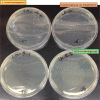Antimicrobial Activity of a New Class of Phosphorylated and Modified Flavonoids
- PMID: 31460413
- PMCID: PMC6681995
- DOI: 10.1021/acsomega.9b00077
Antimicrobial Activity of a New Class of Phosphorylated and Modified Flavonoids
Abstract
The surge of resistant food pathogens is a major threat worldwide. Previous research conducted on phytochemicals has shown their antibacterial activity against pathogenic bacteria. The design of antimicrobial agents to curb pathogenic disease remains a challenge demanding critical attention. Flavonoids such as apigenin and quercetin were evaluated against Gram-positive and Gram-negative bacteria. The results indicated that the antibacterial activity of each flavonoid occurred at a different minimum inhibitory concentration. However, the antimicrobial activity results of the modified flavonoids were also reported, and it was observed that the Gram-positive bacteria were more susceptible in comparison to the Gram-negative bacteria. The cell wall structure of the Gram-positive and Gram-negative bacteria could be the main reason for the bacteria susceptibility. Modified flavonoids could be used as a suitable alternative antimicrobial agent for the treatment of infectious diseases. Our results indicated 100% inhibition of Listeria monocytogenes, Pseudomonas aeruginosa, and Aeromonas hydrophila with modified flavonoids.
Conflict of interest statement
The authors declare no competing financial interest.
Figures







References
-
- Ahmad A.; Kaleem M.; Ahmed Z.; Shafiq H. Therapeutic potential of flavonoids and their mechanism of action against microbial and viral infections—A review. Food Res. Int. 2015, 77, 221–235. 10.1016/j.foodres.2015.06.021. - DOI
-
- Mandalari G.; Bennett R. N.; Bisignano G.; Trombetta D.; Saija A.; Faulds C. B.; Gasson M. J.; Narbad A. Antimicrobial activity of flavonoids extracted from bergamot (Citrus bergamia Risso) peel, a byproduct of the essential oil industry. J. Appl. Microbiol. 2007, 103, 2056–2064. 10.1111/j.1365-2672.2007.03456.x. - DOI - PubMed
LinkOut - more resources
Full Text Sources
Molecular Biology Databases

